Welcome to our comprehensive guide on weed management in sugarcane farming! As a sugarcane grower, you must understand the importance of maintaining a weed-free environment for optimal crop yield and quality. However, dealing with weeds can be challenging due to their rapid growth and ability to compete with sugarcane for nutrients and water. This blog explores simple and effective strategies to control weeds to help you make informed decisions and ensure a successful sugarcane harvest.
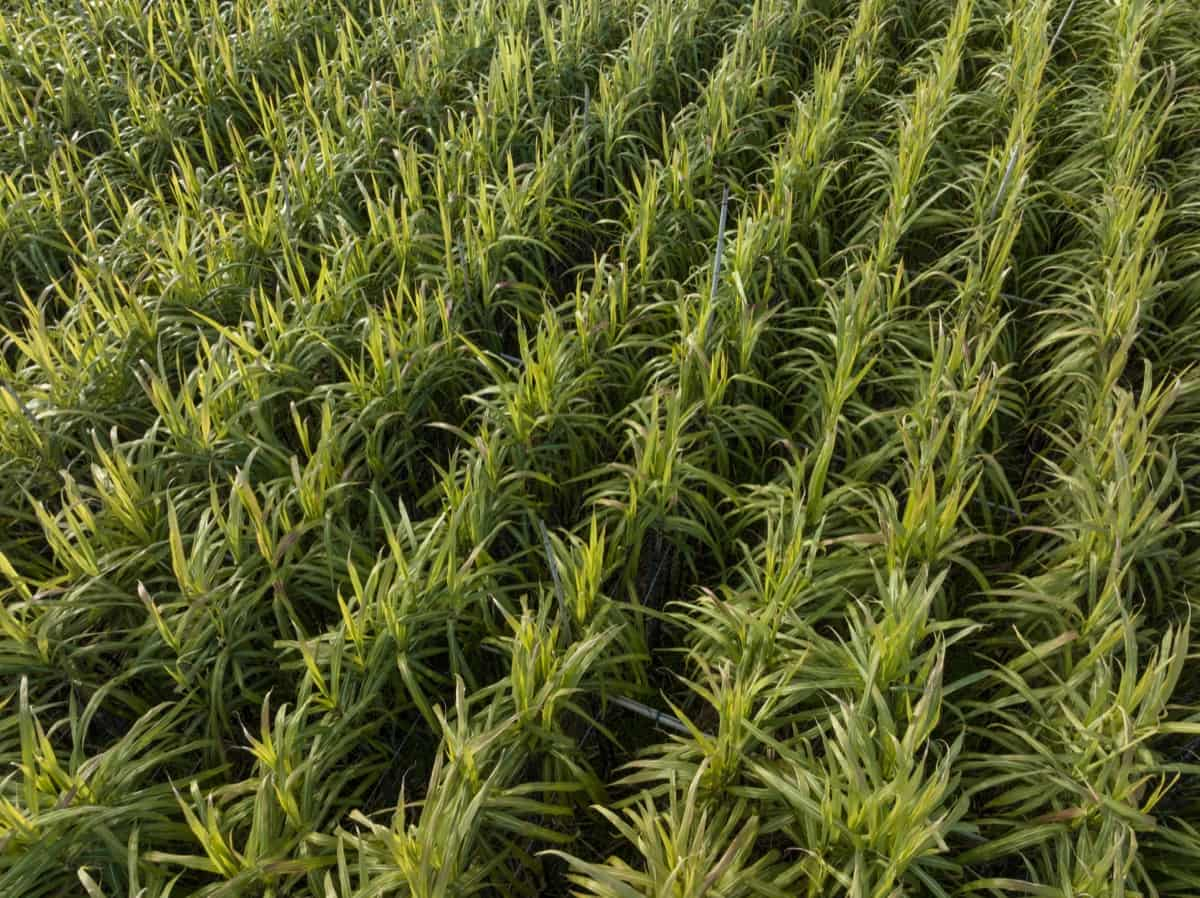
What is Weed Management in Sugarcane?
Weed management in sugarcane is an aspect of crop production, as weeds pose significant challenges. They compete with sugarcane for essential resources like water, light, and nutrients, necessitating effective control measures. To address this issue, chemical weed control using pre-and post-emergence herbicides is commonly employed due to the vast size of sugarcane fields, requiring swift and cost-effective approaches.
However, some weed species have developed resistance to herbicides previously effective, necessitating adaptation in control methods. Geographic variations in sugarcane cultivation can influence weed species composition, demanding specific herbicides and application durations. To achieve high sugarcane yields, selecting appropriate genotypes with superior productivity and adaptability to environmental stress and selective herbicides is essential.
Moreover, alternative strategies like integrated weed management, crop rotation, and diverse herbicide mechanisms can help curb weed resistance and minimize herbicide damage to crop plants. Implementing these practices will ensure sustainable and successful sugarcane farming, enhancing overall yield and quality.
Integrated Weed Management in Sugarcane Farming
Integrated Weed Management (IWM) is a holistic and sustainable approach to combat weed issues in sugarcane farming. It combines multiple weed control strategies to achieve efficient and long-term weed suppression while minimizing environmental impact. Scientifically proven, IWM integrates cultural, biological, mechanical, and chemical methods to create a well-rounded and effective weed management plan.
Cultural practices like proper crop rotation and planting high-yielding sugarcane varieties can reduce weed infestations and improve crop competitiveness. Biological control methods employ natural enemies of weeds, such as insects or pathogens, to keep weed populations in check. Mechanical techniques like hand weeding or using machinery can physically remove weeds from the fields.
Incorporating these strategies with judicious use of herbicides helps prevent weed resistance and minimizes the chemical load on the environment. By implementing Integrated Weed Management, sugarcane farmers can optimize weed control, promote sustainable farming practices, and ensure better crop productivity.
Chemical Weed Control Methods for Sugarcane
Chemical weed control methods for sugarcane involve addressing two major weed groups: broad-leaved (dicotyledonous) and narrow-leaved grassy (monocotyledonous) weeds. To combat broad-leaved weeds like ‘bathua’, matri, Krishna Neel, gari, motha, and circle, a successful approach is spraying a mixture of 2-40 @ I kg in 800 liters of water about a month after sowing. However, the challenge lies with grassy weeds, as sugarcane belongs to the grassy monocotyledonous group.
In case you missed it: Pest and Disease Management in Sugarcane: Causes, Symptoms, Chemical, and Biological Control
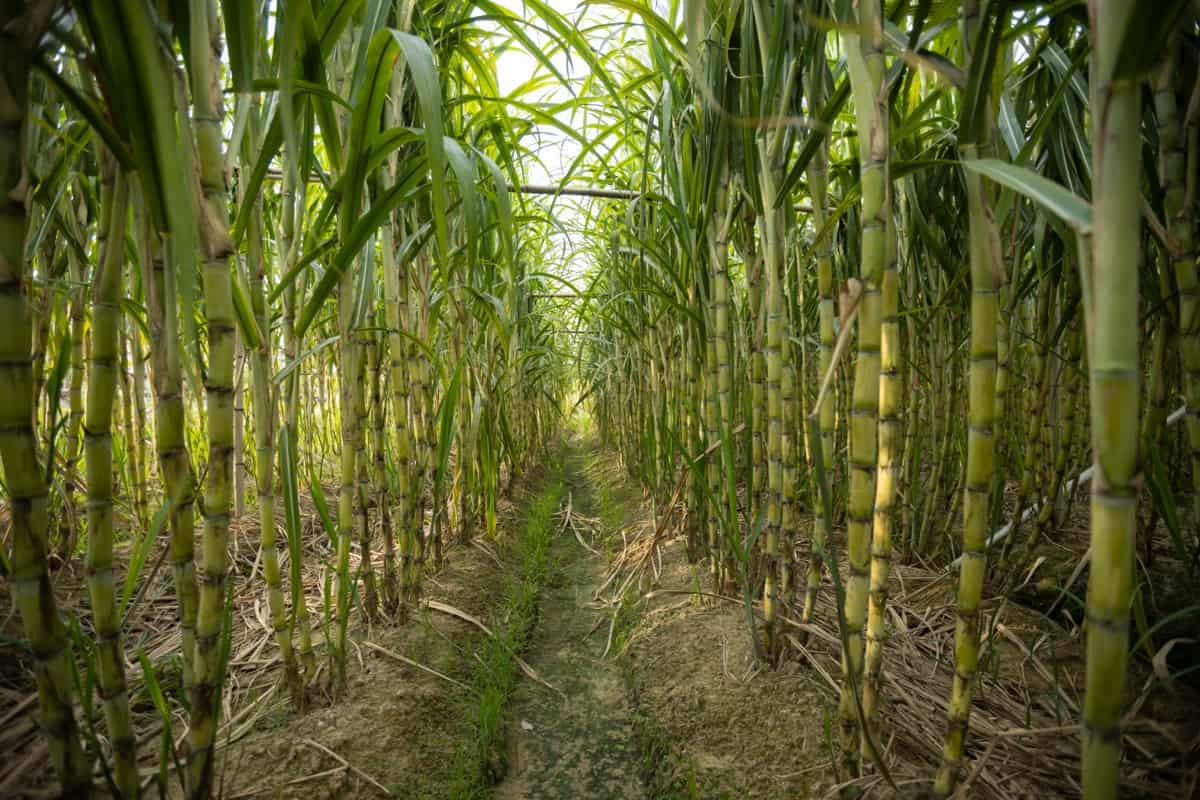
Effective control involves hand hoeing. At times, before sugarcane sprouting, a spray of 2 kg Dilapon or Paraquat in 500 liters of water eliminates standing grasses after sprouting and applying 2 kg of Atrazine or Simazine in 500 liters of water curbs weed growth. Precision is vital: a sub-lethal dose targets sugarcane, while a lethal dose targets weeds, ensuring successful weed management while safeguarding the crop’s health and yield.
Organic Weed Management Practices in Sugarcane Cultivation
Mulching of organic materials, such as straw or sugarcane trash, helps suppress weed growth by blocking sunlight and providing a physical barrier. Intercropping with cover crops like legumes or grasses competes with weeds for resources and releases allelopathic compounds inhibiting weed germination. Regular manual weeding or using hand tools to remove weeds is effective in smaller-scale sugarcane farms.
Organic herbicides derived from natural sources, such as acetic acid-based products, can provide selective weed control without harming sugarcane. Employing flame weeding using propane burners effectively targets weed seedlings. Biological control methods, such as introducing weed-eating insects or using beneficial microbes, also play a role in managing weeds in organic sugarcane farming.
Mechanical Weed Control Techniques for Sugarcane Farms
Mechanical weed control techniques play a role in managing weeds in sugarcane farms due to the crop’s long duration and vulnerability to various weed types. Perennial, seasonal, annual, and grassy weeds can all be problematic, competing with sugarcane for essential resources like nutrients, space, and light while fostering disease and insect development.
Rainy seasons witness the rapid growth of weeds like Echinochloa colonum, E. crusgalli, Dacryloctanum aegyptium, Amaranthus viridis, and Celosia argentia. Weeds like Cyperus rotundus, Cynodon dacrylon, and Sorghum halepense emerge before the monsoon starts, accompanied by annual varieties like Chenopodium album, Lathyrus sativa, Vicia spp., Angallis arvensis, and Fumaria parviflora.
Mechanical weed control involves using tools like kurpi or spades for hoeing the fields approximately a month after sowing. Repeating this process eliminates weeds, encourages sprouting and tillering, and enhances soil aeration. Some farmers maximize the benefits of this labor-intensive operation by cultivating a second crop alongside sugarcane, creating a mixed crop system.
Pre-emergence Herbicides for Weed Management in Sugarcane
Pre-emergence herbicides are valuable tools in weed management for sugarcane cultivation. These herbicides are applied before weed seeds germinate, preventing their growth and competition with young sugarcane plants. One commonly used pre-emergence herbicide is “Atrazine.” It effectively controls various grassy and broadleaf weeds, giving sugarcane a competitive edge during early growth.
In case you missed it: Sugarcane Farming in the USA: How to Start, Production States, Ideas, and Tips
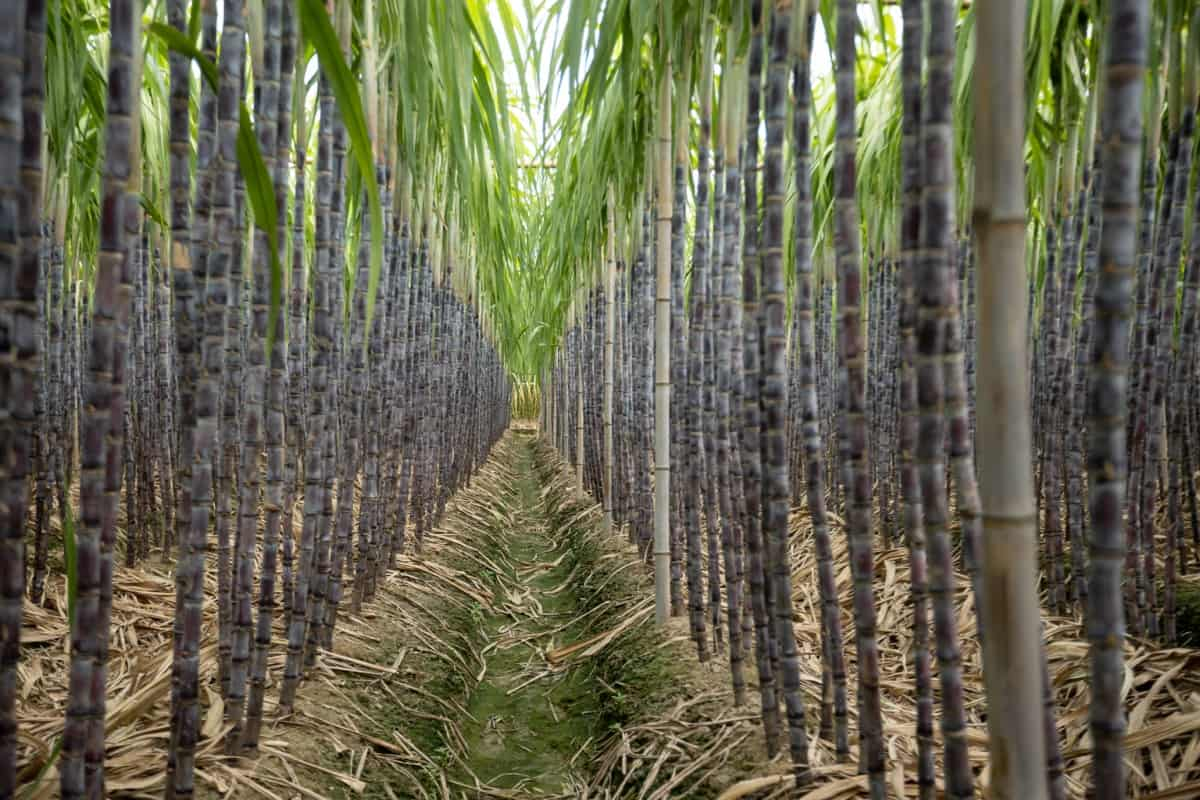
Another example is “Metribuzin,” which targets broadleaf weeds like “Amaranthus spp.” and “Chenopodium album,” suppressing their emergence and growth. “Diuron” is another pre-emergence herbicide utilized in sugarcane fields. It works against various weed species, including grasses and broadleaf weeds.
“S-metolachlor” is also effective in preventing weed seedling emergence and promoting clean sugarcane stands. Additionally, “Pendimethalin” is well-known for its broad-spectrum control, inhibiting the growth of various annual grasses and broadleaf weeds.
Post-emergence Herbicides for Controlling Weeds in Sugarcane Fields
Post-emergence herbicides are essential tools for effectively controlling weeds in sugarcane fields. These herbicides are applied after weed emergence and target actively growing weeds, leaving the sugarcane crop largely unaffected. One common post-emergence herbicide is Glyphosate, which effectively controls a broad spectrum of weeds, like grasses and broad-leaved varieties. Another effective option is 2,4-D, primarily targeting broad-leaved weeds while sparing sugarcane.
For grassy weed control, farmers often use herbicides like Glufosinate or Sethoxydim. These herbicides have selective action against grasses, minimizing damage to sugarcane. Additionally, Clethodim is known for its efficacy in managing grassy weeds like Cyperus spp. and Cynodon dactylon. Post-emergence herbicides offer convenience and precision in targeting specific weed species, helping maintain a weed-free environment in sugarcane fields, and promoting optimal crop growth and yield.
Selective Herbicides for Weed Control in Sugarcane Crops
Selective herbicides play a role in effective weed control in sugarcane crops by targeting specific weed species while sparing the sugarcane plants. One common selective herbicide used in sugarcane fields is Atrazine. It controls grassy weeds like Cynodon dacrylon (doob) and Sorghum halepense (banchari) without harming the sugarcane crop.
Another selective herbicide is Simazine, which effectively targets broad-leaved weeds like Chenopodium album (bathua), Lathyrus sativa (matri), and Vicia spp. (ankrni), Angallis arvensis (Krishna Neel) and Fumaria parviflora (gari) while being safe for sugarcane. Metribuzin is also a selective herbicide that controls grassy and broad-leaved weeds in sugarcane fields. It is effective against Cyperus rotundus (motha), Echinochloa colonum, and E. crusgalli (grasses), among others, without causing harm to the sugarcane plants.
Non-selective Herbicides for Broad-spectrum Weed Management in Sugarcane
These herbicides effectively control many weed species without being specific to particular plants. One prominent example is Glyphosate, a popular non-selective herbicide widely used in sugarcane fields. Glyphosate targets the enzyme in plant growth, causing weeds to wither and die.
In case you missed it: Top 24 Steps to Boost Sugarcane Yield: How to Increase Production, Size, and Quality
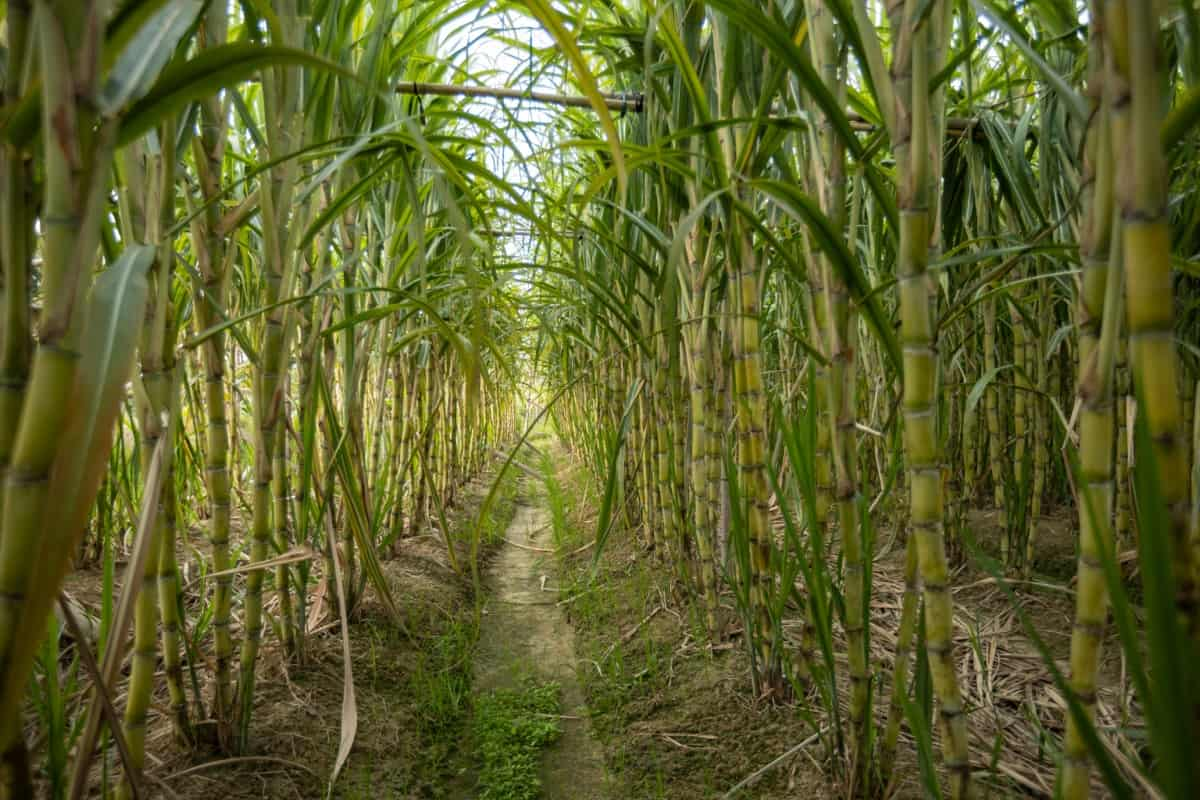
It is applied to the entire field, leaving sugarcane unaffected due to its genetically engineered tolerance to the herbicide. Another effective non-selective herbicide is paraquat, which disrupts photosynthesis in plants, leading to weed elimination. Paraquat is commonly used as a pre-planting herbicide to clear fields before sugarcane cultivation begins.
Cultural Practices to Suppress Weeds in Sugarcane Farming
Cultural practices suppress weeds in sugarcane farming, providing sustainable and cost-effective solutions. Planting dense and healthy sugarcane stands helps create a natural weed barrier, minimizing weed establishment and competition. Optimal row spacing and crop density can effectively shade out emerging weeds. Timely and proper irrigation and fertilization practices support vigorous sugarcane growth, giving the crop a competitive advantage against weeds.
Regular soil cultivation and ridging around sugarcane plants disrupt weed growth and prevent their spread. Crop rotation or intercropping with leguminous crops reduces weed pressure and enhances soil fertility. Using weed-free sugarcane seeds and clean planting materials prevents the introduction of weed seeds into the field. Additionally, timely and efficient harvesting practices limit weed seed production and minimize their return to the soil.
Mulching as a Weed Control Measure in Sugarcane Cultivation
By covering the soil around sugarcane plants with organic materials like straw or sugarcane trash, mulching acts as a physical barrier, weed growth by blocking sunlight and hindering weed seed germination. This practice also helps conserve soil moisture, reducing water evaporation and promoting better water retention for sugarcane roots.
Additionally, mulching regulates soil temperature, keeping it cooler during hot periods and warmer during colder times, benefiting sugarcane growth. Mulch also aids in preventing soil erosion, protecting the soil from heavy rain and wind impact.
Biological Control Methods for Managing Weeds in Sugarcane Fields
Biological control methods offer environmentally friendly approaches to managing weeds in sugarcane fields. These methods utilize natural organisms to suppress weed growth and minimize their impact on crop productivity. One effective biological control method is using weed-eating insects or insects that parasitize weeds. These insects feed on specific weed species, reducing their population and spread.
Additionally, some beneficial microbes, like certain fungi and bacteria, can inhibit weed growth through allelopathy, releasing compounds that hinder weed germination and development. Another biological control strategy is introducing cover crops or companion plants that outcompete weeds for resources. These cover crops can act as living mulches, preventing weed growth by shading and smothering them.
Crop Rotation Strategies to Minimize Weed Infestation in Sugarcane Farms
Crop rotation is an effective strategy to minimize weed infestation in sugarcane farms. By alternating sugarcane cultivation with other crops, weed growth is disrupted, reducing the weed seed bank in the soil. Introducing different plant species helps break the life cycle of specific weeds that may have adapted to sugarcane fields.
In case you missed it: Best Fertilizer for Sugarcane: Organic, Biofertilizers, NPK, Compost Manure, and Schedule
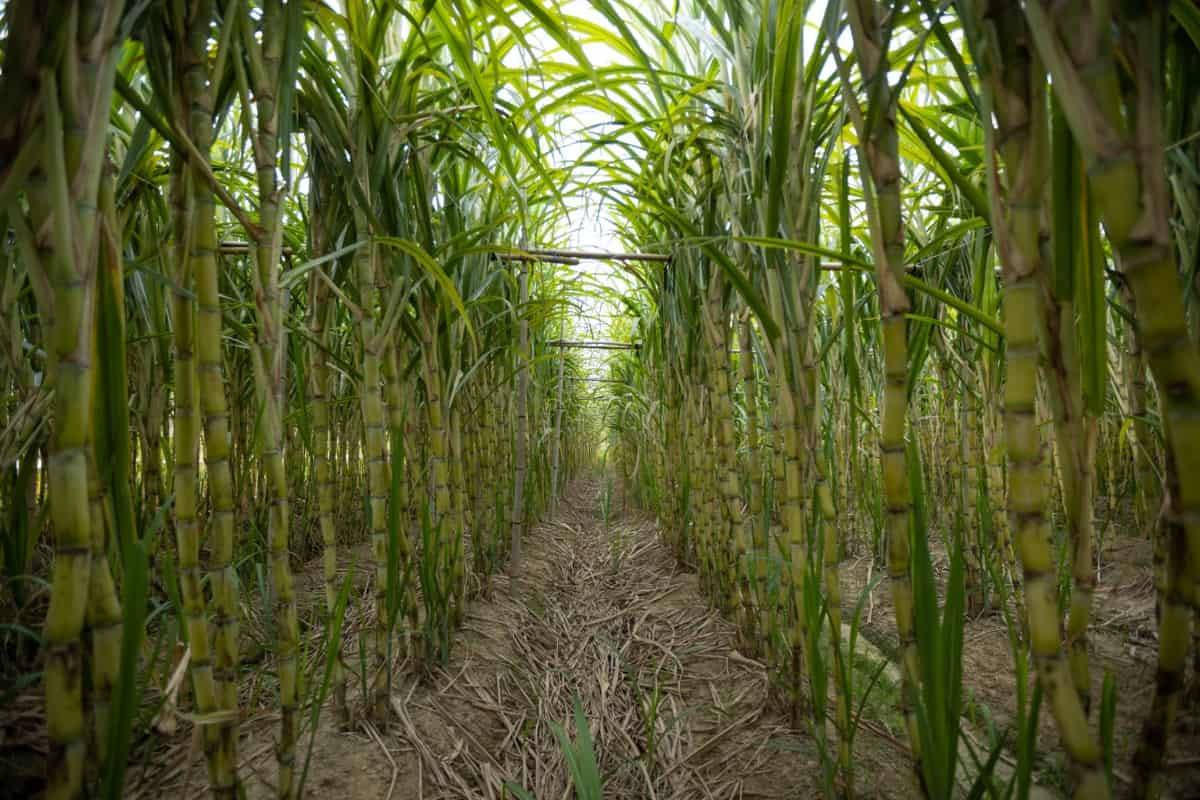
For instance, rotating with legumes or cereals can create a less favorable environment for certain weed species. Different crops have diverse root systems, which can compete with weeds and reduce their dominance. Implementing crop rotation practices strategically can significantly reduce weed pressure and enhance.
Weed Identification and Monitoring Techniques in Sugarcane Production
Identifying and monitoring weeds in sugarcane production is crucial as they compete with the crop for essential resources and create conditions favorable for pests and diseases. Weeds encompass seasonal, annual, and perennial varieties, each posing unique challenges. To identify weeds, farmers can visually inspect the fields regularly and categorize them based on growth patterns and characteristics.
For instance, during the rainy season, weed species like Echinochloa colonum, E. crusgalli, Dacryloctanum aegyptium, Amaranthus viridis, and Celosia argentia emerge rapidly. Before the monsoon begins, Cyperus rotundus, Cynodon dacrylon, and Sorghum halepense, along with annual weeds like Chenopodium album, Lathyrus sativa, Vicia spp., Angallis arvensis, and Fumaria parviflora, become prevalent. Monitoring techniques involve regular field surveys and using tools like quadrats or transects to assess weed density and distribution.
Herbicide Resistance Management in Sugarcane Weed Control
Continuous and excessive use of herbicides can lead to the development of herbicide-resistant weed populations, reducing the effectiveness of these chemicals over time. To combat herbicide resistance, farmers should adopt integrated weed management strategies. These include rotating different herbicides with distinct modes of action, utilizing cultural practices like crop rotation, cover cropping, and mulching, and incorporating mechanical weed control methods.
Examples of herbicide resistance in sugarcane weed control include cases where weed species have evolved resistance to specific herbicides, rendering them ineffective. For instance, grassy weeds like Echinochloa spp. and Cyperus spp. have resisted certain herbicides commonly used in sugarcane fields.
Sustainable Weed Management Approaches for Long-term Sugarcane Cultivation
Weed Management in Sugarcane
- Critical Period of Competition: Weeds are most threatening during tillering (60-120 days after planting).
- Cultural Management: Deep summer plowing, short-duration crops, and intercropping with lowland rice help minimize weed infestation.
- Mechanical Control: Hand weeding, spade digging, and three-tined cultivator intercultivation effectively remove weeds.
- Mulching: Applying 7.5-10 t/ha of sugarcane trash mulch with 10 cm thickness conserves soil moisture and suppresses weed growth.
- Herbicides: Pre-spraying Atrazine (2 kg/ha) followed by 2,4-D (1.0 kg/ha) at 60 DAP provides a weed-free environment.
In case you missed it: Weed Management in Wheat Farming: How to Control with Organic, Chemical and Cultural Practices
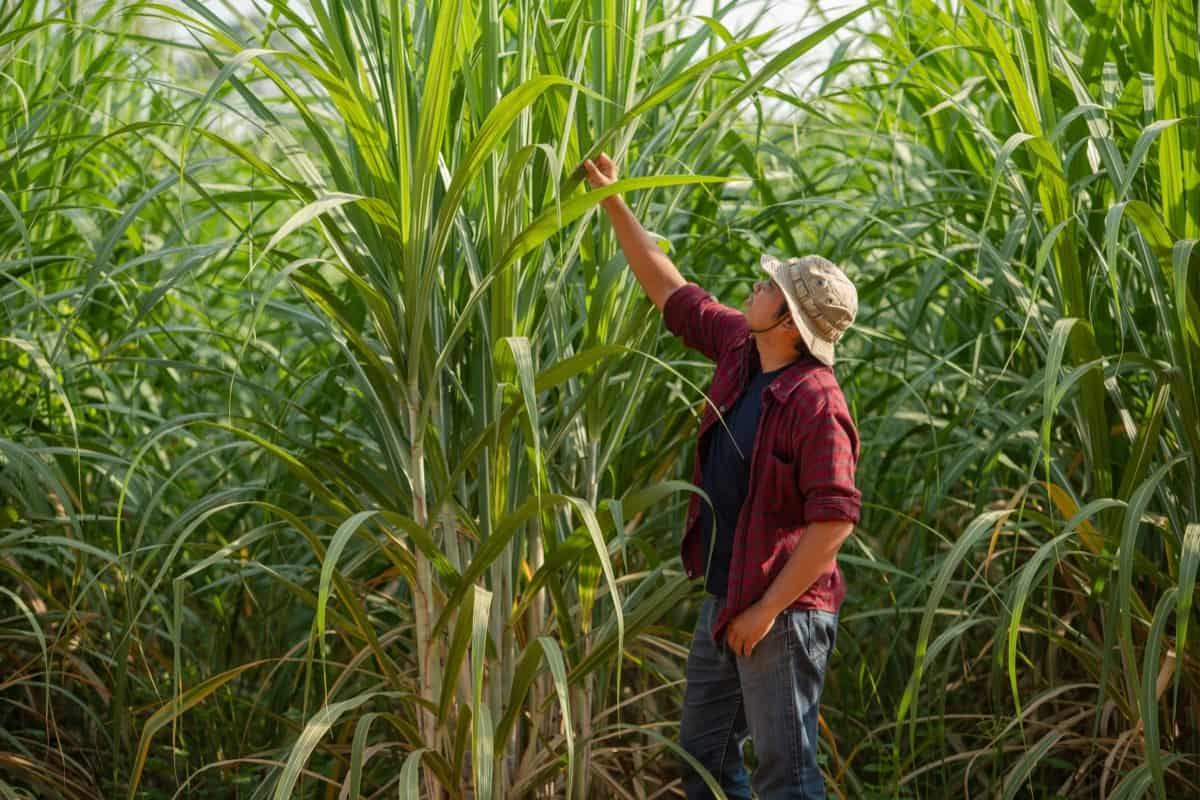
Weed Management in Ratoon Sugarcane Planting
- Critical Period of Competition: Early 30-60 days are crucial for weed control.
- Cultural and Mechanical Control: Initial plowing, off-barring, and trash mulching offer effective weed control.
- Herbicides: Pre-spraying Atrazine (2 kg/ha) or blanket spraying Glyphosate (1.0 L/ha) after ratoon initiation provides weed-free conditions.
- Integration: Combining herbicide use with manual weeding at 60 DAP yields the best results.
Conclusion
Effective weed management in sugarcane farming is essential to maximize crop yield and quality. Integrating chemical, mechanical, and organic approaches helps control weeds and ensures a successful sugarcane harvest.
- Types of Pesticides Used in Agriculture: A Beginner’s Guide
- Economical Aquaculture: A Guide to Low-Budget Fish Farming
- 15 Common Planting Errors That Can Doom Your Fruit Trees
- How to Make Houseplants Bushy: Effective Tips and Ideas
- Innovative Strategies for Boosting Coconut Pollination and Yield
- Pollination Strategies for Maximum Pumpkin Yield
- The Complete Guide to Chicken Fattening: Strategies for Maximum Growth
- Natural Solutions for Tulip Problems: 100% Effective Remedies for Leaf and Bulb-Related Issues
- Revolutionizing Citrus Preservation: Towards a Healthier, Greener Future
- Natural Solutions for Peony Leaf and Flower Problems: 100% Effective Remedies
- Maximizing Profits with Avocado Contract Farming in India: A Comprehensive Guide
- Natural Solutions for Hydrangea Problems: 100% Effective Remedies for Leaf and Flowers
- The Ultimate Guide to Choosing the Perfect Foliage Friend: Bringing Life Indoors
- From Sunlight to Sustainability: 15 Ways to Use Solar Technology in Agriculture
- The Ultimate Guide to Dong Tao Chicken: Exploring from History to Raising
- The Eco-Friendly Makeover: How to Convert Your Unused Swimming Pool into a Fish Pond
- Mastering the Art of Delaware Chicken Farming: Essentials for Healthy Backyard Flocks
- 20 Best Homemade Fertilizers for Money Plant: DIY Recipes and Application Methods
- How to Craft a Comprehensive Free-Range Chicken Farming Business Plan
- Brighten Your Flock: Raising Easter Egger Chickens for Beauty and Bounty
- How to Optimize Your Poultry Egg Farm Business Plan with These Strategies
- Subsidy for Spirulina Cultivation: How Indian Government Schemes Encouraging Spirulina Farmers
- Ultimate Guide to Raising Dominique Chickens: Breeding, Feeding, Egg-Production, and Care
- Mastering the Art of Raising Jersey Giant Chickens: Care, Feeding, and More
- Ultimate Guide to Raising Legbar Chickens: Breeding, Farming Practices, Diet, Egg-Production
- How to Raise Welsummer Chickens: A Comprehensive Guide for Beginners
- How to Protect Indoor Plants in Winter: A Comprehensive Guide
- Ultimate Guide to Grow Bag Gardening: Tips, Tricks, and Planting Ideas for Urban Gardeners
- Guide to Lotus Cultivation: How to Propagate, Plant, Grow, Care, Cost, and Profit
- Agriculture Drone Subsidy Scheme: Government Kisan Subsidy, License, and How to Apply Online
- Ultimate Guide to Raising Araucana Chickens: Breed Profile, Farming Economics, Diet, and Care
- Bringing Hydroponics to Classroom: Importance, Benefits of Learning for School Students
- Ultimate Guide to Raising Polish Chickens: Breed Profile, Farming Economics, Diet, and Care
- Ultimate Guide to Raising Australorp Chickens: Profile, Farming Economics, Egg Production, Diet, and Care
- Silkie Chicken Farming: Raising Practices, Varieties, Egg Production, Diet, and Care
- Sussex Chicken Farming: Raising Practices, Varieties, Egg Production, Diet and Care